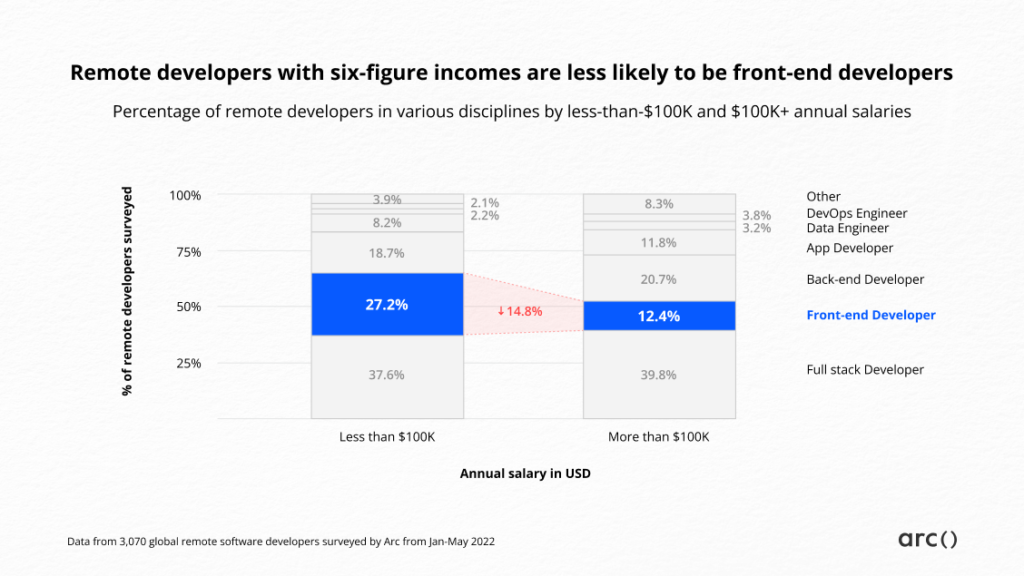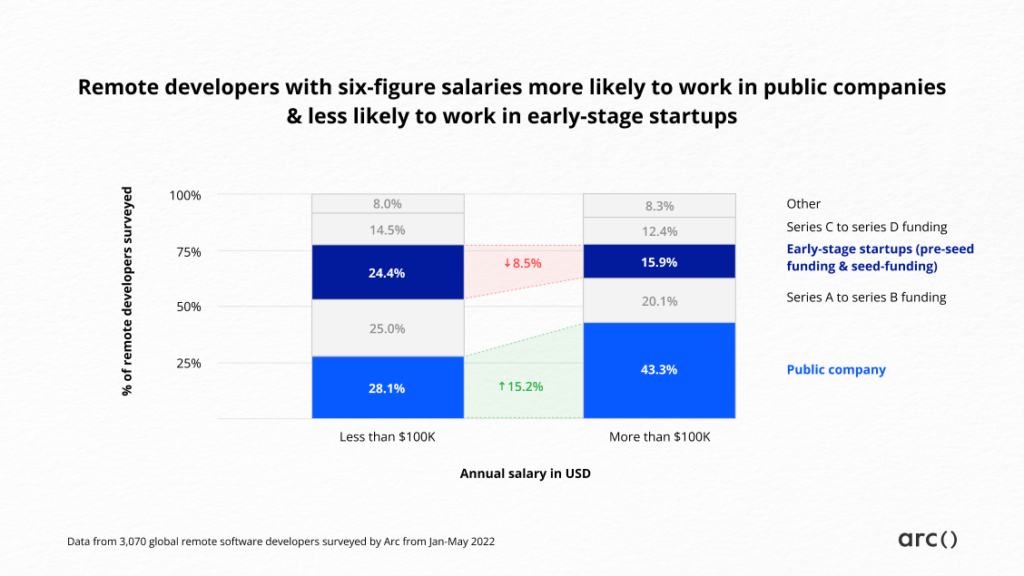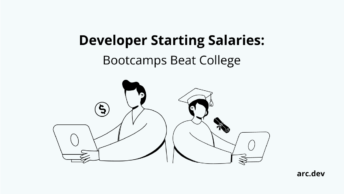Developer jobs consistently rank in the top 10 highest paying professions. Still, not every developer around the world gets paid sky-high salaries. So, we analyzed salary data of 3,070 global remote software developers to find out what developers earning over $100,000 (USD) per year do differently.
Significant differences exist between developers who make $100K per year or more and those who do not. Developers with six-figure incomes are less likely to be front-end developers. They are more likely to work in public companies. They are much more likely to be in the US, work with a US employer, or earn in USD. They often have over six years of experience and are more likely to be team leads.
Only 10.2% of developers surveyed earn an annual salary of $100,000 or more. Arc CEO Weiting Liu says:
Developers who make six-figure incomes are in a league of their own. Not everyone is able to get that kind of salary. But a select group brings in $100K or more per year. Analysis of our salary data shows that strategic pivots — away from or into certain specializations, roles, and employers — can help developers increase their chances of becoming part of this higher-earning group.
Weiting Liu, founder and CEO of Arc
Read on below to see what our data suggest separates these developers from the rest.
Looking to hire the best remote developers? Arc can help you:
⚡️ Get instant candidate matches without searching
⚡️ Identify top applicants from our network of 350,000+
⚡️ Hire 4x faster with vetted candidates (qualified and interview-ready)
Try Arc to hire top developers now →
1. Specialization
Developers with different specializations are paid different salaries. Developers with six-figure incomes are less likely to be front-end developers: 12.4% vs 27.2%.
But it should not deter people interested in front-end development. You can make strategic career choices such as employing a company business stage and employer HQ location to still make six figures.

2. Business stage
Developers earning six figures are significantly more likely to work in public companies. 43.3% of the $100k+ group are from public companies, while only 28.1% of the less-than-$100K group are in public companies. This is because more established public companies can afford to pay higher salaries.
In contrast, developers with $100k+ income are less likely to work in early-stage startups. 15.9% of $100k+ devs work in pre-seed and seed-funded companies, while 24.4% of less-than-$100K devs do so. Part of the reason could be that early-stage startups are in the experimentation stage with unstable business models.

3. Currency
The majority of six-figure developers, at 69.4%, get paid in US dollars. In contrast, only 32.3% of less-than-$100K devs do so.
With the rise in global remote work, developers based anywhere in the world are able to earn in USD — or work with US employers.
4. Country
a. Country of employer HQ
Developers with six-figure incomes are much more likely to work with US employers — 61.5% vs 19.9%. That difference is a whopping 41.5%. This trend is also reflected in our study of Latin American developers who work with US companies to triple their income relative to local employment.
b. Country of residence
Similarly, people making six figures are more likely to be based in the US — 31.8% vs only 0.9%.
5. Years of experience
Developers with a $100K+ salary are more likely to be senior developers with 6 or more years of experience — 68.5% vs 35.8%. Hence, junior developers should be patient. They can expect to get into the six-figure club over time.
6. Role title
Unlike the above factors, the percentage difference between role titles in both groups is minor.
- Devs making $100k+ are more likely to have the title of “Team Lead” – 22.9% vs 15.2%. Team Leads bring additional skills like team leadership and project management.
- Devs making $100K+ are less likely to be “individual contributors.” 59.9% of $100K devs work as individual contributors while 65.2% of less-than-$100K devs do so.
7. Industry
No notable differences exist in how prominent the developers from different industries are. Both the groups are roughly equally likely to be working in sectors such as IT, finance, healthcare, consulting, nonprofit, government, and more.
Conclusion
Making $100K+ while based outside the US as a developer isn’t easy. But strategic choices can increase your chances of entering this higher-earning developer cohort.
Some key factors include choosing disciplines that are more in-demand and have higher pay, working with public companies, and aiming for US-based employers.
You can also explore HireAI to skip the line and:
⚡️ Get instant candidate matches without searching
⚡️ Identify top applicants from our network of 350,000+ with no manual screening
⚡️ Hire 4x faster with vetted candidates (qualified and interview-ready)
Try HireAI and hire top developers now →
Data source
3,070 global remote software developers were surveyed from December 31, 2021, to May 11, 2022. Check the results and add your salary here (updated in real-time).
We excluded the entries in seven figures since they appeared to be too high, especially for the countries of residence, to be correct.
We prorated part-time salaries to full-time.
Percentage of responses by six-figure income:
- Less than 100k USD per annum: 89.8%
- 100k USD or more per annum: 10.2%
What is Arc?
Arc is a radically different remote job search platform for developers. We connect developers worldwide with tech companies hiring remotely.
Developers get featured to companies and land a remote job in 14 days. Sign up here.
Employers can get access to view profiles of pre-vetted remote developers for both permanent and contract roles. Sign up here.









I just wanted to ask, Who manages the tax and employment contracts for the Indian region. Does arc does it all by themselves or hire somebody like Remote.com to manage the taxes in India. Btw loved the article and learned a lot more new things and am grateful for that.
Hi Harshvardhan, thanks for stopping by, and happy to hear you found this article useful! At Arc, we’ve partnered with Deel and Remote, compliance and payroll platforms, to make it easy to do paperwork and hire across borders.
Stunning article Shaifali 🙂 Glad that you shared.